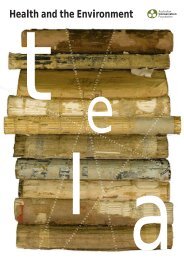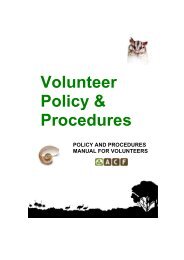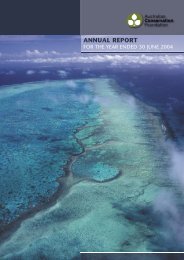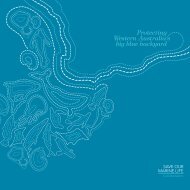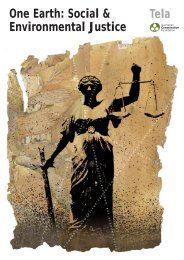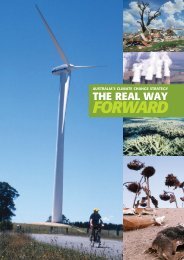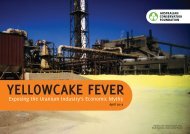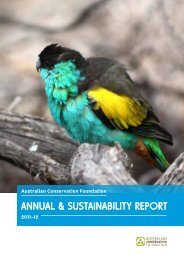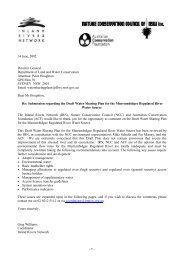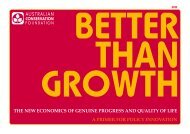Kimberley Appropriate Economics Interim Report - Australian ...
Kimberley Appropriate Economics Interim Report - Australian ...
Kimberley Appropriate Economics Interim Report - Australian ...
Create successful ePaper yourself
Turn your PDF publications into a flip-book with our unique Google optimized e-Paper software.
The Future<br />
The entire river system, including the lakes, is in a state of ecological re-adjustment (Watkins et al 1997).<br />
The dearth of baseline data prior to damming, the relatively short timeframe of regulation, and the lack of a<br />
comprehensive monitoring regime to identify the range and rate of community change makes an accurate<br />
assessment of the magnitude of current and future threats to the ecosystem very difficult (Watkins et al 1997).<br />
It is expected that the problems of the present will be exacerbated if they are not addressed.<br />
From an economic and social point of view, the river is a significant feature and attraction providing water for<br />
recreation, tourism, aquaculture and electricity generation (hydropower). However, many cultural values have<br />
been degraded since damming, including loss of heritage sites and dis-connection to country. Social, economic<br />
and ecological issues of the past are only now beginning to be addressed. In order to provide a healthy river<br />
system able to maintain the wide suite of values across the different sectors, mistakes of the past must be<br />
understood so that a sustainable system is provided for the future.<br />
Summary<br />
An appropriate development considers the full range of values (ecological, social, cultural and economic) and<br />
provides a net benefit. The Ord River Dam is widely regarded as a political decision based on poor economics,<br />
poor science, no ecological sustainability and no regard for Aboriginal custodians (Graham-Taylor 1982).<br />
Given the information outlined above, the Ord I decision was not a sustainable development decision.<br />
The ORIA has not demonstrated best management practice in irrigated agriculture to date, although there are<br />
recent local initiatives to try and improve this situation with the development of a land and water management<br />
plan among other community and agency initiatives (OLW 2000). Irrigation in the <strong>Kimberley</strong> has a relatively<br />
large ecological footprint (water storage, river management, water supply management, land clearing etc) and<br />
social and cultural impact (alienation, access to resources, cultural and heritage disturbance) within a defined<br />
area. The Ord River project has illustrated that the cost of developing irrigated agriculture in remote regions<br />
is very expensive, and the location continues to put producers at a competitive disadvantage. At present, there<br />
is little evidence that further major developments of this nature in tropical northern Australia are justified due<br />
to the costs of development, inherent competitive disadvantages and highly competitive and volatile overseas<br />
commodity markets.<br />
Of particular relevance to future development in the Ord is the WA State Sustainability Strategy Guiding<br />
Principle that “Decision-making processes should effectively integrate both long and short-term economic,<br />
environmental, social and equity considerations” (Government of Western Australia 2003). The Strategy<br />
recognises that while there are a variety of economic opportunities, not all are socially and environmentally<br />
responsible. The future of the Ord, should therefore, act as a case study for northern Australia and embrace<br />
a process that fully integrates economic, environmental and social/cultural factors to promote positive net<br />
outcomes such as a Sustainability Assessment, as advocated in the State Sustainability Strategy. Future<br />
planning decisions in the <strong>Kimberley</strong>, including those on the Ord and any new developments in the Fitzroy,<br />
must consider the full range of values, not just the economic alone if they are to avoid the mistakes of the past.<br />
A community planning process coupled with long term scientific investigation of sustainable use of land and<br />
water for these resources must form part of the sustainability framework for northern Australia.<br />
For the future health of the river system and all the values that rely on it, ORIA Stage I should be made as<br />
sustainable as possible. This will need to include a process to ensure the environmental impacts of Stage 1<br />
are arrested, and wherever possible mitigated. Both Stage I and Stage II should adopt world’s best practice<br />
in irrigated agriculture to avoid exacerbating the problems, or repeating the mistakes created during the first<br />
stage. In addition Stage II should not proceed unless proponents can demonstrate that it will produce a net<br />
positive benefit; ecologically, socially, culturally and economically.<br />
References:<br />
<strong>Australian</strong> Terrestrial Biodiversity Assessment (2002) National Land and Water Resources Audit, Natural<br />
Heritage Trust, Canberra.<br />
Davidson, B. R. (1972) The northern myth: a study of the physical and economic limits to the agricultural and<br />
pastoral development in tropical Australia, 3 rd edition, Melbourne University Press, Melbourne<br />
55



